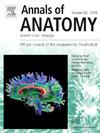咀嚼活动和康复对齿状回分子层星形细胞形态的影响:来自外、中、内亚层的见解及其与空间学习和记忆的关系。
IF 2
3区 医学
Q2 ANATOMY & MORPHOLOGY
引用次数: 0
摘要
齿状回在学习和空间记忆中起着至关重要的作用,特别是在其中间的第三分子层,它通过内侧穿孔路径接收主要传入输入。有趣的是,咀嚼活动的变化被描述为通过可见的星形胶质细胞增生、促炎细胞因子的释放和氧化应激影响该区域,影响突触生理和认知。本研究旨在探讨咀嚼活动改变对年轻瑞士白化小鼠空间记忆的影响,并将这些影响与星形胶质细胞的形态变化联系起来。将小鼠分为三组:硬饲粮加颗粒(HD)、硬饲粮/软饲粮(HD/SD,咀嚼活动减少)和HD/SD/HD(康复)。Morris水迷宫实验测量逃避潜伏期,三维显微重建方法提供星形胶质细胞的形态测量数据。分层聚类分析证实在齿状回分子层的外、中、内三分之一存在4种复杂性递减的形态学亚型(AST1、AST2、AST3、AST4)。咀嚼活动的变化影响了除AST3外中三层星形胶质细胞亚型的数量和分布。典型判别函数分析表明,复杂性是影响集群形成的最大变量。各动物组的复杂性和逃避潜伏期的相关测试显示,HD组在咀嚼活动改变的中间三分之一处具有60%的大效应值(Pearson’s R: 0.605, p < 0.001),具有显著的相关性。在HD组中,中间三分之一的AST3形态与学习和空间记忆功能呈线性相关[Pearson’s R: 0.624, p < 0.001],并且随着咀嚼活动的减少而消失,并且不能通过饮食康复恢复。这一发现没有在内层和外层观察到,支持中间三分之一的AST3对学习和空间记忆的贡献。组间比较试验还显示,饮食对齿状回分子层的星形胶质细胞亚群有不同的影响。数据验证了咀嚼活动对星形胶质细胞复杂性的影响,并表明AST3与年轻雌性小鼠的空间记忆和学习任务存在关联。进一步研究这些关系的潜在机制对于确定认知障碍的潜在治疗靶点和开发有效的干预措施以保持认知功能至关重要。本文章由计算机程序翻译,如有差异,请以英文原文为准。
Impact of masticatory activity and rehabilitation on astrocyte morphology across the molecular layer of the dentate gyrus: Insights from the outer, medial, and inner sublayers and their relationship with spatial learning and memory
The dentate gyrus plays a crucial role in learning and spatial memory, particularly in its middle third molecular layer, which receives the primary afferent input via the medial perforant path. Interestingly, changes in masticatory activity are described to affect this region with visible astrogliosis, release of pro-inflammatory cytokines and oxidative stress, affecting synaptic physiology, and cognition. This study aimed to investigate the impact of altered masticatory activity on spatial memory in young Swiss albino mice, correlating these effects with morphological changes in astrocytes. The mice were divided into three groups: Hard diet with pellets (HD), hard diet/soft diet (HD/SD, reduced masticatory activity), and HD/SD/HD (rehabilitated). The Morris water maze test was used to measure escape latency, while three-dimensional microscopic reconstruction methods provided morphometric data on the astrocytes. Hierarchical clustering analysis validated the existence of four morphological subtypes with decreasing complexity (AST1, AST2, AST3, and AST4), in the outer, middle, and inner thirds of the dentate gyrus molecular layer. Changes in masticatory activity affected the number and distribution of astrocytes subtypes excepting AST3 in the middle third layer. Canonical discriminant function analysis indicated that complexity was the variable most influencing cluster formation. Correlation tests between complexity and escape latency for each animal group showed a significant correlation with a large effect size of 60 % [Pearson’s R: 0.605, p < 0.001] in the HD group in the middle third, which was disrupted by altered masticatory activity. AST3 morphotype in the middle third showed a linear correlation with learning and spatial memory functions in the HD group [Pearson’s R: 0.624, p < 0.001] that disappeared with a reduction in masticatory activity, and nor restored by diet rehabilitation. This finding was not observed for inner and outer layers, supporting the contribution of middle third AST3 to learning and spatial memory. Group comparison tests also revealed that diet differentially impacts astrocyte subpopulations on each third of the dentate gyrus molecular layer. Data validate the influence of the masticatory activity on astrocyte complexity and suggest the existence of AST3 association with spatial memory and learning tasks in young female mice. Further research on the underlying mechanisms of these relationships is essential to identify potential therapeutic targets for cognitive disorders and to develop effective interventions to preserve cognitive function.
求助全文
通过发布文献求助,成功后即可免费获取论文全文。
去求助
来源期刊

Annals of Anatomy-Anatomischer Anzeiger
医学-解剖学与形态学
CiteScore
4.40
自引率
22.70%
发文量
137
审稿时长
33 days
期刊介绍:
Annals of Anatomy publish peer reviewed original articles as well as brief review articles. The journal is open to original papers covering a link between anatomy and areas such as
•molecular biology,
•cell biology
•reproductive biology
•immunobiology
•developmental biology, neurobiology
•embryology as well as
•neuroanatomy
•neuroimmunology
•clinical anatomy
•comparative anatomy
•modern imaging techniques
•evolution, and especially also
•aging
 求助内容:
求助内容: 应助结果提醒方式:
应助结果提醒方式:


